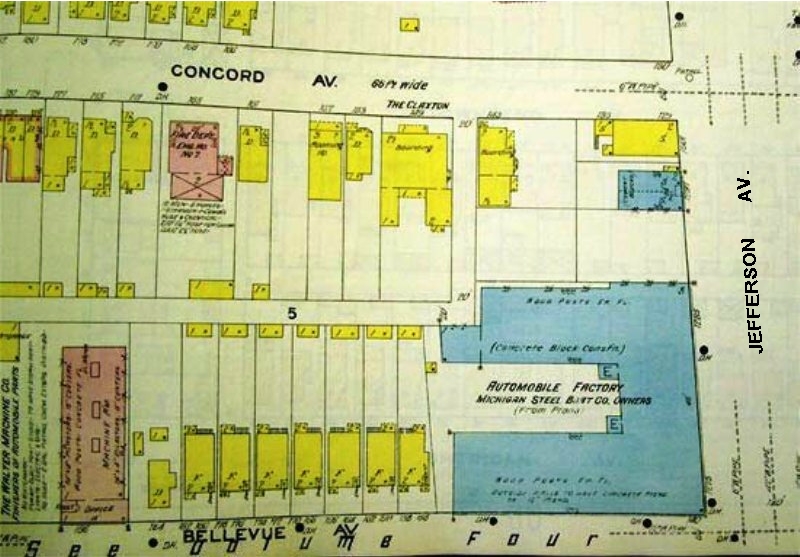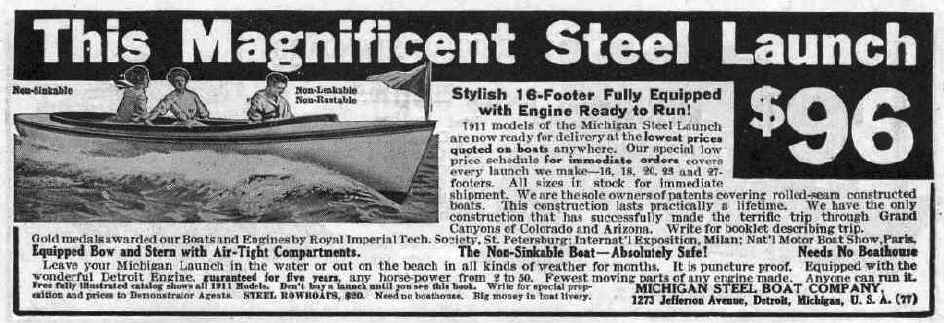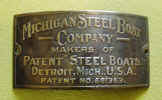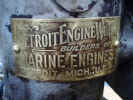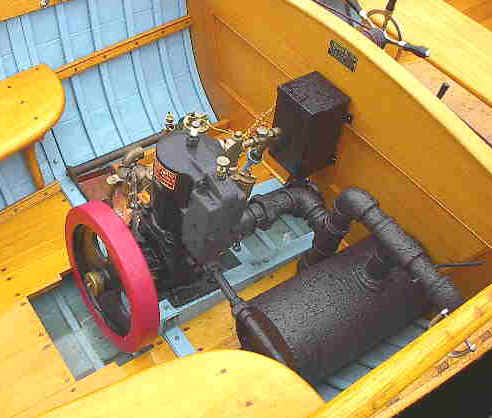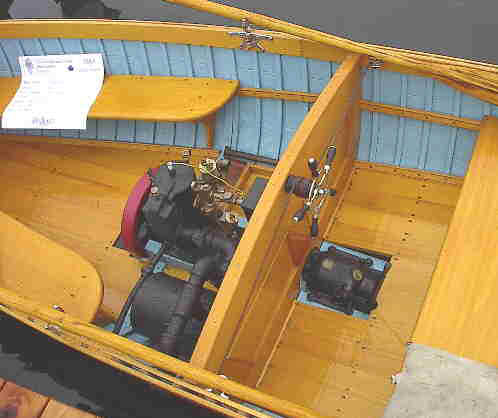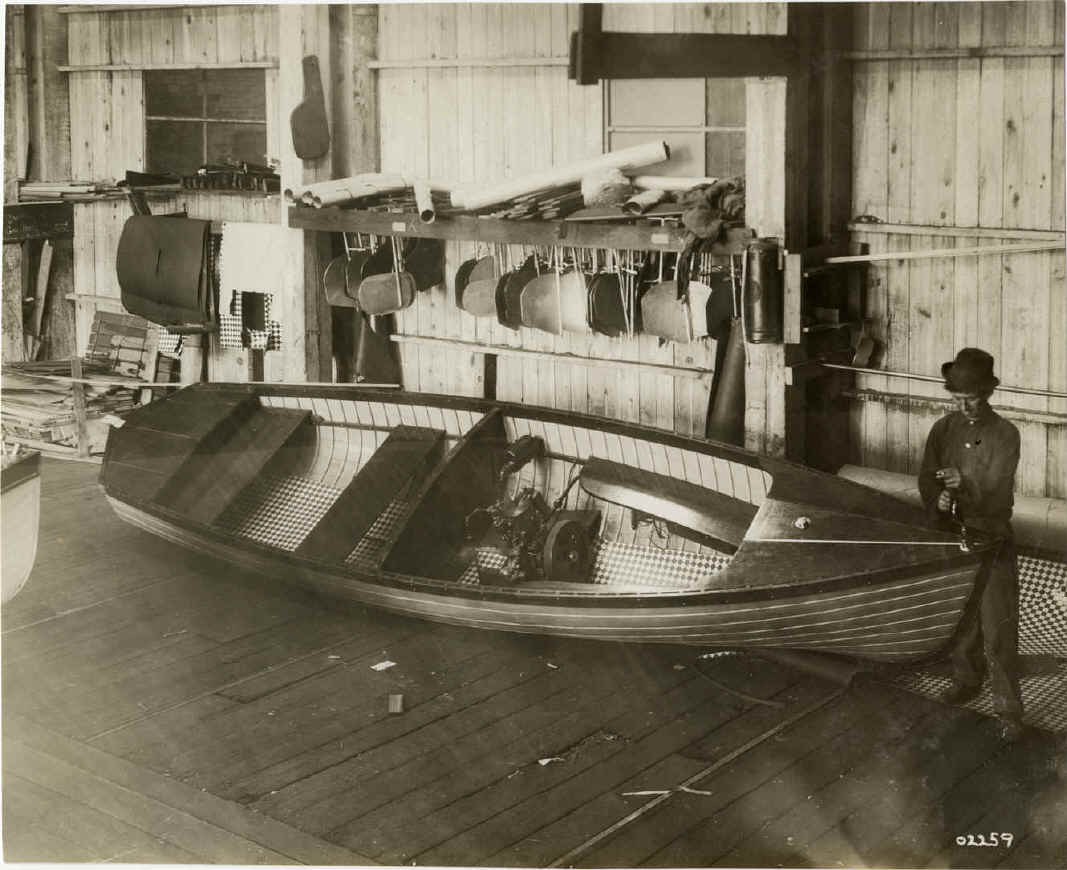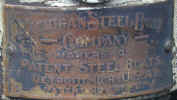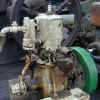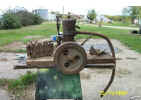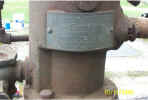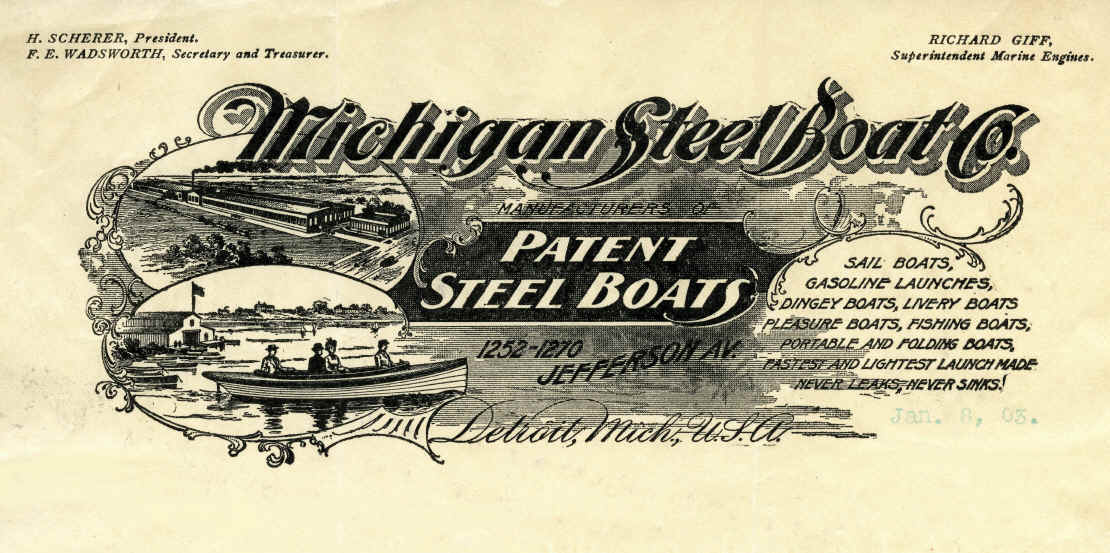
|
|
The firm marketed boats under the __________________________________________________________ ______________ "Michigan Steel Boat Co.. purchases the old "Detroit Boast the largest
boat plant in the world" "Detroit will have the largest boat-building
plant in the world. The Michigan Steel Boat Company yesterday bought
out the old Detroit United Railway car barns property on Jefferson
avenue from Olds Motor Works. About 700 men will be employed in
building steel and wooden boats and canoes. The new owners (Frederick
Wadsworth & Hugo Scherer) will take immediate possession of the
property and will begin moving into its new quarters this morning. A
considerable portion of the machinery formerly used by the Olds people
has been bought by the boat company and this will be utilized in the
extended operations which will be undertaken. ___________________________________ Surviving
advertisements indicate that Scherer and
Above is a scan of a page from the old Sanborn fire insurance map that shows one of the Detroit factories owned by Wadsworth Mfg. Co. and MSBC at 1275-1285 East Jefferson Ave. between Bellevue Ave. and Concord Ave. The automobile factory was Wadsworth Mfg. Co., Michigan Steel Boat Co., Detroit Motor Car Supply Co., Detroit Engine Works. The June 23, 1910
issue of the Automobile reported: Detroit June 2, 1910 – Two new automobile companies have been formed here during the past week. They are the Hupp-Yeates Electric car Company, $100,000 capital, which will build a new type electric and a concern headed by Hugo Scherer and F.E. Wadsworth of Michigan Steel Boat Company which will have a capitalization of $250,000 and which will build a small car of more horsepower, about 100-inch wheelbase, to weigh under 1,900 lbs. This car will sell for under $1,000. The partner’s car was to be called the Tom Thumb, and was named after Peter Cooper’s diminutive steam locomotive that ushered in the railroad age in 1830. Another news item relating to the Tom Thumb followed: This building at the corner of _____________________________________________
Detroit, Mich.--The Michigan Steel Boat Company has bought the old Detroit United Railway car barns property on Jefferson avenue from the Olds Motor Works, and will employ about seven hundred men in building steel and wooden boats and canoes. A 1905 description of the property called it “the largest steel boat building establishment in the state.” The plant covered a space of 1,200 X 100 feet with seven separate buildings. The main factory and office building was a two-story high cement block structure, complete with show rooms. All buildings had automatic fire extinguishers and a private telephone system. Motive power for the plant was electricity, furnished by the company’s own private generating plant. The company in its new location appears to have gotten off to a good start as it reported that 1,200 boats were built in 1905.
Michigan Steel Boat Company may have
been the manufacturer of the “White Flyer” rowboats for Sears,
Roebuck & Company in 1908. The boat was shipped direct from “our
factory at Detroit, Mich.” and retailed at $27.50, including one pair
of oars and oarlocks. A rudder cost an extra $1.75. The “White
Flyer” was a 14-foot square stern steel clinker rowboat of
“Apollo” steel construction, with horizontal plates. Sears
advertised that the “bow, stern and seats of this boat are made of
cypress, the gunwales are of oak, all finely finished in natural oak.”
The boat came equipped with patented steel airtight chambers at either
end for additional buoyancy. The hull was painted with white pegamoid,
and imported waterproof paint, the same as that used by the United
States Navy. The catalogue No. 6K8700 “White Flyer” was 14 feet in
length; 43-1/2" beam amidship, and 14" in depth amidship, with
the height of the bow being 22" and the height of the stern being
24". The boat weighed about 150 pounds and when crated weighed
about 200 pounds.
By 1915 the firm had grown to
include these managers and officers: Hugo Scherer, President;
Frederick E. Wadsworth, Secretary and Treasurer; H. E. Cronenweth,
General Manager; W. C. Rowling, Purchasing Agent; and A. M. Ratigan,
Advertising Manager. The company manufactured “Boats, Motor Boats,
Row Boats, Canoes” The address and phone were listed as 1526
Jefferson Ave., Tels. East 406-407-408. Beeson’s
Marine Directory 1908 Many
pleasure boats building: The
past winter and during the spring every builder of pleasure vessels
has been and is being kept very busy…The Michigan Steel Boat
Company, one of the largest builders of small pleasure vessels in the
country, have been running to their full capacity all of the past
winter on work that was delivered this spring. This
company is now experimenting on a new type of motor boat 35 feet long
to take the place of their regular 30-foot launch, of which they
constructed so many in the past…. M.S.B.C. 1910
Catalog. By 1916 Michigan Steel Boat
Company had moved its office and factory to the corner of Kercheval
Avenue and East Jefferson Ave. (Conners Creek area), and was still
associated with The Wadsworth Manufacturing Company, manufacturers of
auto bodies, auto tops and auto parts. Frederick E. Wadsworth was
president of the firm, Mary M. Wadsworth, vice-president and H. E.
Cronenweth, treasurer. M.S.B.C.
out of business Dec 8, 1920. December 8, 1920,
Michigan Steel Boat Company filed a notice of dissolution. The reason;
the firm’s plant and headquarters had just been purchased by the
American Motor Body Company.
|
| A Special Michigan Steel Boat |
A fine example of a steel motor-boat in popular demand back in the early 1900's is this Special 18-foot model built by the Michigan Steel Boat Company, of which four photographs are shown, This has a beam 4 feet 6 inches and the cockpit is 11 feet 7 inches forward, and 1 foot 10 inches aft. Equipped with a 3-1/2 hp Detroit engine, the boat makes a speed of 10 miles an hour. It seats ten persons in all, the forward cockpit seating six, having seats 4 feet 6 inches wide. The net weight of the boat is 650 pounds. The measurements boxed are 18 feet 3 inches by 4 feet 8 inches by 3 feet 4 inches, or 284 cubic feet. The price of this model in 1910 complete with engine installed ($147.00, crated, f.o.b. cars at Detroit) brings it within the reach of the most moderate incomes of the time period. In materials, workmanship and power, this 1910 boat is fully up to the well known standards of the Michigan Steel Boat Company in every respect. The launch could be equipped with an engine as large as 12-14 hp if
desired. With such an engine installed it has made actual speed over a
measured course of 19 miles an hour. The price with the larger
engine was comparatively higher. |
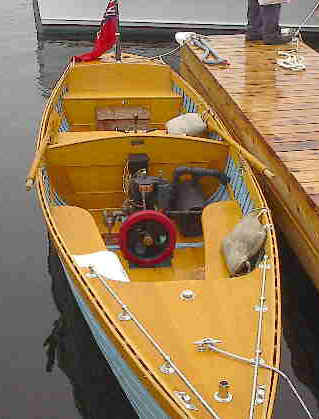
1908 Michigan Steel Boat 18ft, Owner of the Boat is unknown.
|
|
One
of the leaders in steel boat construction back in the late 1800's and
early 1900's was the
Michigan
Steel
Boat
Company, of
Kalamazoo, Michigan, who turned out thousands of boats annually.
These boats were built clinker fashion of heavily galvanized steel, cut in
regular pattern strips, lock seamed and welded together by pneumatic
hammers. The builders said they have never believed in the modern wash tub
as a boat, as there is to much risk about it, so each strip is cut from a
regular pattern and conforms without strain to the beautiful curves which
distinguish their boats and give them a distinctive poise in the water.
The lapping, seaming and grooving of the steel strips is by a special
process, and the seams running from stem to stern have each four
thicknesses of steel, which gives the hull great strength. The steel is
then treated on the exposed surface with a special adhering aluminum
paint which the United States Government used at that time period to perfect the steel clad
monsters of our navy. This in addition to the galvanized steel renders the
boats equally immune from the effects of salt and of fresh water. Each boat is fitted
with air-tight compartments, and the water-tight compartments are
thoroughly tested before they are put in the boat. For the amateur builder
the construction of a steel boat is practically out of the question. The
prices at which these steel boats could be purchased, however, place them
within the easy reach of the general public. The Michigan Steel Boat Company was originally located at 102 Mill Street, Kalamazoo, Michigan and owned and operated by C.G. Bullard and his brother, organized in the late 1800's. The steel hull boats could be purchased with any brand engine you wanted installed ready to put in the water and run. Some of the engines that are known to have been installed and retagged with the MSBC brass name tag was DEW, DMCSC, TMC. The steel hull boats could also be purchased with out a engine for those who desired to save a little money and do it themselves. The launch hulls with no engine came with woodwork, gasoline tank, engine bed, rudder, post, yoke and shoe, but did not include engine, engine fittings, shaft, propeller or stuffing box. By the end of 1901 Frederick E. Wadsworth who owned Detroit Engine Works purchased the Michigan Steel Boat Co. and moved it to Detroit located at 1250 East Jefferson Ave. After the purchase there was more emphasis put on selling the boats with their on brand engines installed.
16 foot Regular
Launch Dimensions : Length,
16' ; Beam, 4' 2" ;
Draught loaded about 12".
Seating capacity, 6 to 7 persons.
Speed, about 6 to 7 miles an hour.
Weight, crated 700 pounds. Measurement boxed for
export, 16'x5'x3' = 240 cubic feet. Gross weight, boxed, 900
pounds. Frame
: Ribs of best selected white oak, 7/8x1/2 spaced
4" centers. Hull of galvanized steel cut in strips and lock
seamed, making it impossible to pull apart. Boat has six water-tight
compartments.
18 Foot Automobile Boat Dimensions : Length, 18' : beam, 4' 6" ; draught,
about 14";
seating capacity, about 10 to 12 persons; depth amidship, 2'
2" height of bow, 2' 4" ; height of stern, 2' 5" ;
length of cockpit, 10' 3"
; width of cockpit, 3' 6". Speed with 2 hp engine, about 7 miles per
hour. Shipping weight, 1,000
pounds. Capacity gasoline
tank, 10 gallons. Measurement boxed for export, 18' 3" x 4' 8" x
3' 4" = 284 cubic feet. Gross
weight, boxed, 1,125 pounds. Decking : Fore and aft decks of wood, covered with paint canvas, ecru color, same as up-to-date yachts are finished. Cockpit : Sealed up in a narrow strips of cypress ; seats extend fore and aft full length of cockpit. Fittings : Woodwork filled and finished with spar varnish; each boat fitted with heavy shoe under the rudder to protect rudder and propeller should the boat run into an obstruction. It also has brass and cherry trimmed steering wheel in bow, and chocks and cleats on forward deck. Engine : 2, 3, 3-1/2, 4, or 5, 6 H. P. two-cycle reversible high speed Detroit engine, with all latest improvements. All engines thoroughly tested both before and after they have been put in the boat.
Dimensions : Length 21'; beam, 5'8"; draught loaded, about 20"; speed, about 8 to 12 miles per hour. Shipping weight, crated, about 1,500 pounds. Measurement boxed for export, 21' 6" x 5' 3"x 4' = 538 cubic feet. Gross weight, boxed, 1,900 pounds. Frame : Ribs of best selected white oak, 1-1/2x7/8 inches, spaced 5" centers. Keel, keelson, stem, stern-post, dead-woods, floor beams and deck carlings best quality clear white oak. Hull of galvanized steel cut in strips and lock seemed, making it impossible to pull apart. These seams running from bow to stern are like steel girders encircling the boat, making it the staunchest boat possible. Decking : Fore and aft of cypress, covered with heavy canvas, painted ecru color, set in white lead, the most serviceable deck known to up-to-date builders. Length forward deck 4' 7"; length aft deck, 4' 6". Cockpit : Ceiled up inside with narrow strips of pine. Solid matched flooring. Seats running fore and aft full length of cockpit, with an extra wide seat athwartships, aft. Length of cockpit, 12' 3"; width, 4' 10". Coaming, best quality white oak, 6" high forward and 4" aft. Fittings : All woodwork finished in natural color. Metal painted with silver steel aluminum paint, the paint adopted by United States Government in painting the new navy. All Michigan steel launches are fitted with a heavy shoe under rudder to protect entirely the rudder and propeller, should the boat run into an obstruction. Riveted to this shoe, just forward of the propeller wheel, and bolted through the keelson, is a solid brass shaft hanger, which, besides strengthening the shoe, relieves the shaft of vibration. A brass steering wheel is fitted regularly forward with steel cored cable running under half to quadrant on rudder post under aft deck, thus leaving the decks and cockpit entirely free of all running gear. Chocks and cleats on forward deck are also included. Motor : 5-6hp and 7 to 8 Detroit single cylinder reversible engine, or 10hp double cylinder, or 12 to 14hp double cylinder.
25 Foot Launch Dimensions
: Length,
25'; beam, 6' 6"; draught loaded, about 22". Seating capacity,
18 to 20 persons. Speed, with 5-6hp engine, 8 to 9 miles per hour.
Shipping weight, crated, 1,900 pounds. Measurement boxed for export, 27'x
6'x 4' = 720 cubic feet. Gross weight, boxed, 3,000 pounds.
Resources:
Collected from a 1910 book written by Thomas H. Russel |
|
| Main Menu |
